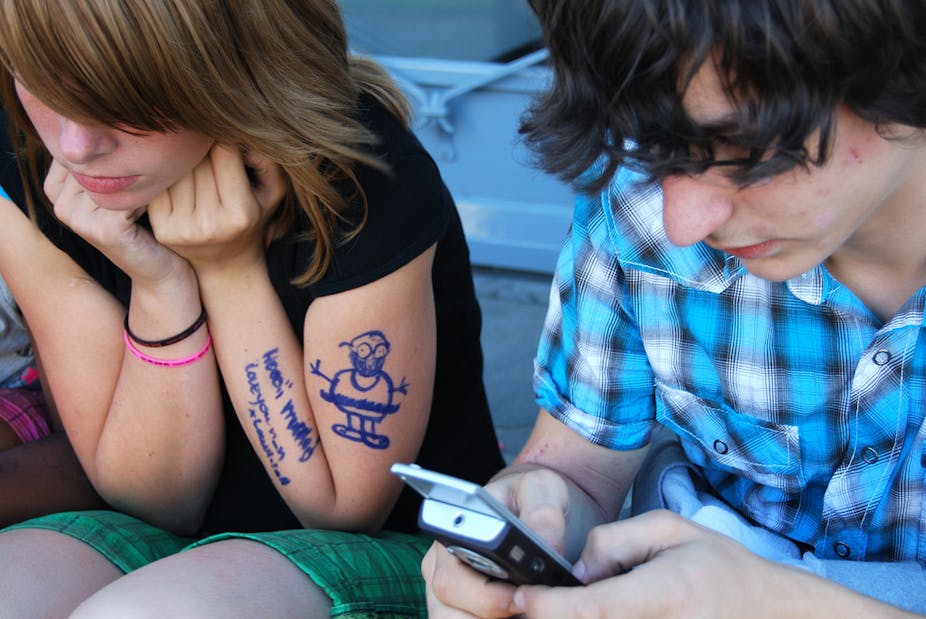Cases of teenagers “sexting” each other have recently provoked panicked responses by media, parents, educators and policy makers in Australia. Now a Victorian parliamentary inquiry into the practice has been told it’s better to use discretionary powers to deal with sexting cases rather than new laws.
“Sexting” can mean the creating, sharing, sending or posting of sexually explicit messages images or videos via the internet, mobile phones or other electronic devices. There’s growing concern among parents of young people and others in the legal and wider community about the appropriateness of criminalising sexting for youth.
While the age of criminal responsibility varies from state to state, Australian children and teens who engage in sexting practices run the risk of being prosecuted under child pornography laws. They can face severe sanctions.
And once young people are classified as sex offenders, they face long-term consequences, such as having their careers curtailed. Clearly its not in the public interest when such outcomes are the result of consensual sexual activity.
Sexting and the law
The law currently fails to distinguish between consensual and non-consensual sexting. Consensual sexting is when a minor takes a sexually explicit image of her or himself and sends it to someone else. In such instances, it’s clear that no one is harmed or assaulted when the photograph is taken. Nor is anyone hurt when it is initially transmitted to its willing recipient.
Non-consensual sexting may involve coercion or blackmail in the taking of the picture. And significant harms result from further dissemination of images, which is also non-consensual.

Because sexting episodes are very diverse, they cannot be easily categorised. In some cases, a teen might take pictures and send them to an adult with whom the minor has an exploitative relationship. In other cases, it may be difficult to determine whether teens who exchange images agreed about to what use the image may be put.
So the complications of distinguishing between consensual and non-consensual sexting are immense. Especially when we look at the practice as it occurs among all the complexities of teen social contexts.
Despite a lot of public interest and concern about teen sexting, there’s little research of it in the context of local teen peer cultures. A recent report from the United Kingdom conducted interviews with teens about their views and experiences of sexting. It found that for teens, sexting involves “a range of activities which may be motivated by sexual pleasure but are often coercive, linked to harassment, bullying and even violence.”
Researchers also found considerable evidence of the age-old double standard – sexually active boys are admired and “rated”, while sexually active girls are denigrated and despised as “sluts”. This evidence suggests girls are more adversely affected by sexting because it often mirrors the norms of pop culture. And, of course, in pop culture trading and circulating images of female bodies holds social currency.
Sexism in our responses
In Australia, the government has tried to educate and intervene in teen sexting practices through film campaigns such as Meaghan’s Story and Tagged.
Unfortunately, these campaigns perpetuate the message that girls are to blame for the negative consequences of a “sext gone viral”. Writing on this issue recently, researchers quoted a blogger who notes the sexism inherent in such messages, “Imagine a drink-driving ad that showed a pedestrian being run over, the car zooming away, and then a caption that said – Watch where you’re walking, pedestrians.”

In the Tagged “educational” film, girls are warned about the social and psychological “risks” of sending images of themselves to boys they may be interested in or dating. Boys are not cautioned about the ethics of passing images on to others. But they are warned that non-consensual sexting might get them on the sex offender register.
Individual accountability, responsibility, and victim-blaming appear to be the most common approaches to tackling the complex issues around teen sexting. This clearly needs to change. What is needed is a more rational and informed response to sexting.
Sexting, discretion and the law
A recent study in the US showed that as many as 24% of 14- to 17-year-olds surveyed had engaged with some kind of sexting practice. We can safely assume that the practice is just as widespread in Australia. Unless current legal and policy responses to sexting are reconsidered, a quarter of the current teen population could end up prosecuted for creating, possessing, or distributing nude images.
Once a youth has been charged, and guilt has been established, there’s no discretion for taking him or her off the sex offenders’ register. What’s more, how different states police children and young people in this area is inconsistent. Discretion is fundamental to ensuring that laws designed to protect young people do not result in the shaming or automatic criminalisation of teens involved in sexting.
The challenge to overcome here in addressing the failures of current legal responses to sexting lies in finding ways to acknowledge the diverse contexts in which teens engage in sexting, as well as address the harms that can result for teens facing peer pressure to engage in the practice.
We need to change the way the law tackles this complicated issue and ensure it’s done with sensitivity. Most of all, we need to prevent the unnecessary prosecution of young people.

